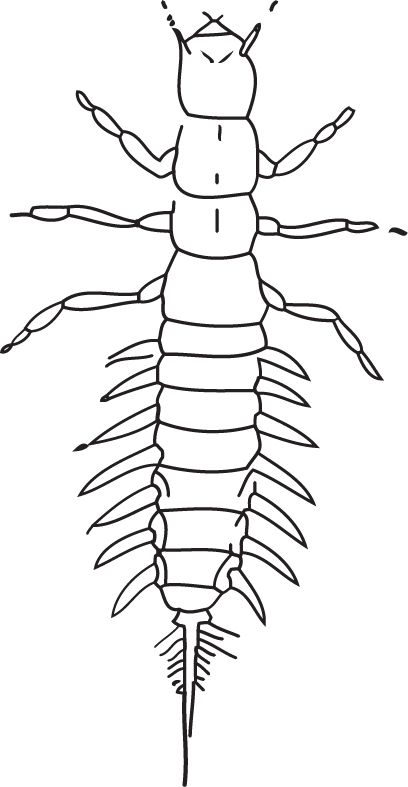Fishflies, dobsonflies & alderflies larvae
Source: University of Kentucky Entomology
See how they move!
SCIENTIFIC NAME: Megaloptera
Number Of Species/Distribution
There are about 300 species of fishflies, alderflies, and dobsonflies worldwide.
They inhabit both North and South America, and can also be found in Southern Africa, parts of Asia and in Australia.
43 different species have been found in Canada and the United States.
Megaloptera species are most diverse in temperate regions, with less diversity found in the tropics.
The megaloptera group includes fishfly, alderfly and dobsonfly species.
Diet/Feeding
Most megaloptera larvae are predaceous and will eat most other small invertebrates.
Prey include various aquatic insects, larvae, clams, worms and crustaceans.
Megaloptera larvae are equipped with strong clamp-like mouth parts (called mandibles) that they use to grasp their prey.
As adults, they may feed on flower nectar or plant sap.
Many male adults do not feed at all.
Habitat
Megaloptera larvae live in diverse aquatic habitats including in streams, rivers, lakes, ponds, and swamps.
They can survive in both still or quickly flowing waters.
They are benthic dwelling and can be found burrowed in soft mud or sand, or may take shelter under stones or in crevices.
Most need aquatic environments that have high amounts of oxygen in the water in order to breathe.
Some species can survive in low oxygen concentrations by using special appendages called 'caudal respiratory tubes'. These tubes work like snorkels, allowing the larvae to access oxygen from above the surface of the water.
Only in the larval stage do megaloptera live in the water; all other life stages are terrestrial, staying close to aquatic habitats.
INTERESTING FACTS
Megaloptera are among the largest of the aquatic insect larvae.
The adults are rarely seen. This is because they tend to be most active at night, and also have very short lifespans, living in secluded environments.
The adult stage usually looks very different from its larval stage.
Male dobsonflies use specialized appendages called 'mandibles', which are very long, to fight each other for females to mate with.
These appendages are known as 'tusks', and can make the male adult look very fierce. Nevertheless, they are harmless to people.
Life Cycle
Megalopterans undergo complete metamorphosis. This involves passing through 4 complete life stages, which are the egg, larvae, pupa, and adult stages.
Eggs
Adult female megaloptera lay up to 3000 eggs.
They tend to deposit eggs on vegetation or rocks that protrude from the surface of the water.
Females will try to select shady areas for egg deposition in order to protect the eggs from the heat of the sun.
Approximately 1 to 2 weeks after being laid, the egg mass turns into a liquid, and the newly hatched larvae drop into the water.
The hatching usually occurs at night.
Larvae
The larval stage can last 1-5 years depending on environmental conditions, including climate and food sources.
Megaloptera larvae shed their outer layer (called 'moulting') about 10 to 12 times during development before entering the pupal stage.
Pupal
When megalopteran larvae are ready to pupate, they climb a few centimetres out of the water onto land.
On land, they find a safe spot to pupate, such as under a log or into the soil.
The pupae spend approximately 1 to 4 weeks in its safe cavity before emerging as an adult.
Adults
Adults usually emerge in late spring to mid-summer, and are ready to mate upon emergence.
Mating usually occurs on plants close to the water.
Females of some species of dobsonflies and alderflies use special chemicals (called 'pheromones') to attract mates.
Males of some species will hold the female's wings in his jaw before mating begins.
Adult megaloptera live only a few days to a few weeks, and die shortly after mating and depositing eggs.
The life cycle of a megaloptera may take only one year to complete in warmer areas, but can take up to 5 years in colder climates.
Role In Food Chain
Megaloptera larvae are an important predator in aquatic ecosystems; they eat many types of aquatic organisms and are eaten by many species of fish.
Sources
Animal Life Resource (2010). Fishflies Dobsonflies and Alderflies. Available here.
Canada's Aquatic Environments (2002). Megaloptera. Available here.
DMI International Corporation (2003). LaMotte Aquatic Macroinvertebrate Insect Identification Flashcards.
The Commonwealth Scientific and Industrial Research Organization (2010). Megaloptera-Dobsonflies and Alderflies. Available here.
University of California, Berkeley (2007). Dobsonflies, Fishflies, and Alderflies (Megaloptera). Available here.
University of Kentucky Entomology. (2018). Dobsonflies and Fishflies. Available here.





